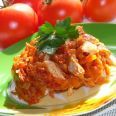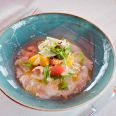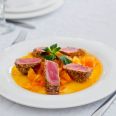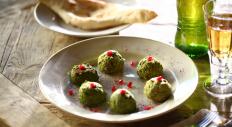Russian Kvass
Russian kvass is one of the best soft drinks. Its flavouring and nutritious characteristics are unrivalled. Invented over a thousand years ago, it still enjoys deserved popularity

Russian kvass is one of the best soft drinks. Its flavouring and nutritious characteristics are unrivalled. Invented over a thousand years ago, it still enjoys deserved popularity.
The first records of kvass in Russia date back to 989 AD when Vladimir, Prince of Kiev, was baptising his subjects. The chronicle says, "Give the people food, honey and kvass".
Kvass made of rye or barley malt does not only possess high flavouring characteristics, but also revitalizes and normalizes metabolism. Its effect is similar to that of kefir, curdled milk, kumiss and acidophilic milk. Alike any other product of lactic acid fermentation, kvass regulates the work of gastrointestinal tract, prevents reproduction of harmful and pathogenic microbes, increases body vitality, improves metabolism, and benefits cardiovascular system. This healing power is conditioned by lactic acid, vitamins, uncombined amino acids, various sugars and microelements.
Kvass increases appetite and possesses high food value. Not surprisingly, people in many West-European countries have been interested in recipes for Russian kvass. At an international exhibition held in Yugoslavia in 1975, Russian kvass (from Moscow) got 18 points, while the famous coke received only 9.8.
Kvass has always been respected greatly in Russia. It was brewed in monasteries and army barracks, hotels and hospitals, mansions and huts. Each family knew how to brew kvass, as well as how to bake bread. Centuries-old experience shows that kvass promotes health and increases working capacity. When doing hard work – mowing, ploughing, firewood chopping – a Russian peasant did not take along milk or fruit drinks; they took kvass, as they believed it to relieve wariness and restore power. This characteristic has been confirmed scientifically.
Light Kvass
rye bread
dry yeast
sugar water
Fill a glass container with rye croutons or dried rye bread (1/5 volume), pour pure cold water. Add dry yeast (a knife tip per litre) and sugar (5 lumps per litre). Close the container and turn it over a few times to stir the ingredients. Loose the lid a little to let in air and leave to brew for a day or two.
Filter the brewed mixture and pour into bottles adding 2 lumps of sugar per 0.5 L (or to taste). Chill the bottles in the fridge.
Home Bread Kvass
500g rye croutons
40g yeast
200g sugar
50g raisins
5-10 fresh mint shoots
3-4 leaves black currants
4L water
Slice the bread and dry it in the oven until dark-brown. Place the dried bread in boiling water and leave to rest 3-4 hours. Filter the brew through several layers of gauze, add sugar, yeast dissolved in cup of brew, mint, and currant leaves, cover with a clean cloth, and leave to rest in a warm place 10-12 hours. After it has brewed thoroughly, filter again and pour in bottles, putting a few raisins into each. Cork the bottles tight and put them in the fridge. The kvass is ready after 3 days.
Ancient White Kvass
500g rue malt
250g barley malt
2kg rye flour
500g buckwheat flour and 500g wheat flour
7L boiled water
This kvass has high flavouring characteristics. It was brewed with carefully selected ingredients and under strictly observed technology. First, they made a brew. For this, they dissolved flour in warm water, added yeast and left the brew to rest. Malt was prepared separately. Usually it consisted of 500g of rye malt and 250g of barley malt. That was combined with water to make the consistency of battering. Then they prepared a flour mix consisting of 2 kg rye flour, 500 g buckwheat flour and 500g wheat flour. The resulting mixture was added to the liquid malt in small portions simultaneously adding hot water and stirring to make it homogeneous. There was 4 times more water (in volume), than flour and malt. The resulting batter was put in a different dish and kept in a warm place for 5 hrs. Then they added 7L of boiled water, stirred thoroughly and added the brew and crisped-leaved mint (dried). The resulting brew was kept 12 hrs in a warm place for fermentation. The brewed kvass was poured into bottles. The bottles were stored in a cold place.
Bread Kvass
1 kg rye bread
7L water
1/2 cup sugar
1/2 cup raisins
30g yeast
Dry bread slices in the oven until dark-brown, pour them with hot boiled water and leave to rest 6-8 hours. Then filter, add yeast and sugar dissolved in warm water, raisins, and leave to brew. Pour the prepared kvass into bottles, cork them and keep them in a cold place.
Caraway Kvass
800g rye bread
7L water
2 cups sugar
1 cup yeast ferment
50g caraway seeds
To prepare the brew combine 1/3 yeast sticks with 1 cup warm boiled water, 1 tsp sugar, 1/2 cup flour and leave for 1-2 hours in a warm place. Dry rye bread slices in the oven until dark-brown, pour them with hot boiled water and leave to rest 3-4 hours. Then filter, add the yeast brew, sugar, caraway seeds and leave to brew 12-15 hours. Pour the prepared kvass into bottles, cork them and keep them in a cold place.
Ginger Kvass
6 ginger roots
12L water
1kg molasses
3 lemons
30g yeast
Put finely chopped ginger roots, molasses, finely chopped, unpeeled, cored lemons in a big saucepan with water, boil thoroughly, chill down to 25-30 C, add 2-3 tbsp liquid yeast, stir thoroughly and leave to brew in a warm place. When the kvass starts brewing well with the sediment and the lemons going up, filter it through several layers of gauze, pour into champagne bottles, cork and lay on ice or put in the cellar. The kvass is ready in 6-7 days.
Barley Kvass
1kg barley
10L water
2 1/3 cups sugar
30-40g yeast
Fry the barley until dark-brown, pour with water, boil for 1 hour, filter. Stir in sugar, chill, add rubbed yeast and leave in a warm place for 1-2 days to brew. When the kvass starts brewing well, pour it into bottles, cork them and keep in a cold place. The kvass is ready in 3-4 days.
Apple Kvass
600g white wheat bread
12L water
10kg apples
2 cups sugar
10g yeast
Slice wheat bread, pour with hot water, leave for 5-6 hours, filter, add sugar and yeast dissolved in warm water, and leave for 10-12 hours to brew, filter. On the previous day, put finely sliced apples into 3L of cold boiled water and leave in a cold place. Before drinking the kvass, add filtered apple brew.
Raspberry Kvass
1kg raspberries
4L water
1 cup sugar
30g yeast
2-3g citric acid
Select good raspberries, rinse them, pour hot boiled water, and bring to boil. Leave to rest 2-3 hours, filter, add yeast dissolved in water, sugar, citric acid, and leave in a warm place to brew 8-10 hours. Then filter the kvass, pour into bottles, cork them, and store in a cold place.
Mint Kvass
50g peppermint
2 cups sugar
5L water
15g yeast
1/2 tsp citric acid
Rinse leaves and young shoots of mint, pour boiling water, add sugar, citric acid, cover with a towel and leave to rest for 12 hours. Then, filter, add yeast and leave in a warm place to brew (until foam appears), chill down and pour into bottles. Consume within two weeks. You can add orange syrup as a flavourer.
Pkhali from the Chef of Kharcho Restaurant
Pkhali is one of the most popular and beloved by many people dishes of the Georgian cuisine. It is very easy to cook and there are so many variations. You may use almost any vegetables and herbs to co...
Marinated cod
There are lots of recipes to cook marinated fish. A great variety of such recipes consists of frying pieces of fish in oil. I would like to offer you a recipe of lean fish in marinade. It gets tasty, ...
Fresh sea bass carpaccio with citrus sauce
Hospitable and vivacious brand-chef of Park Giuseppe Restaurant Sergey Lasarev showed us how to cook fresh sea bass carpaccio with citrus sauce – a simple but dainty food.







